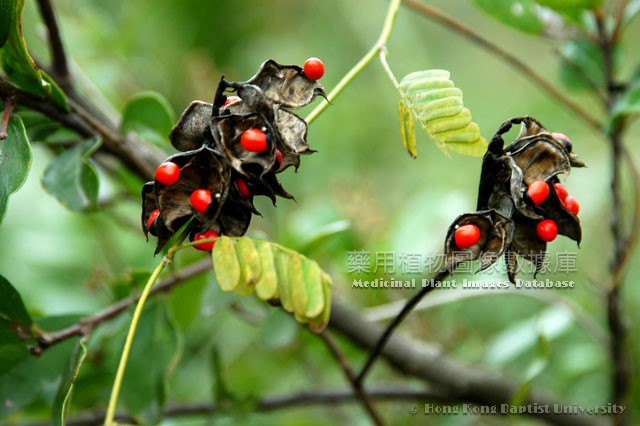|
Abrus precatorius Linn.

|
English Name |
Rosary Pea, Love Pea, Redhead Vine, Wild Liquorice, Coralhead Plant, Rosary-pea Tree, Rosary-pea, Rosarypea Tree, Jequirity Rasarypea, Red-headed Vine, Precatory Bean |
|
Latin name |
Abrus precatorius Linn. |
|
Family & Genus |
Fabaceae, Abrus |
|
Description |
Liana, stem slender, ca. 2mm in diameter, multi-branched, whole plant sparsely white short coarse appressed hairs or bristles. Pinnate leaves with 16-26 leaflets; leaflets opposite, membranous, oblong, 1-2cm long, apex truncate and with small cusps, base obtuse, glabrous above, sparsely coarse appressed hairs below; leaflet stem short. Capitulum axillary, 3-8cm long, no peduncles, rachis very short and fleshy; flowers small, dense, borne at each joint of rachis, with short stem; calyx campanulate, yellow-green, with 4 light teeth, sparsely white coarse appressed hairs; corolla purple, length of petals similar, wide ovate; stamens 9; ovary is pubescent, styles with fine papillae, glabrous. Pod yellow-green, oblong, 2-3.5cm long, apex beak, fruits leathery, densely white short appressed hairs. Seeds 2-6, elliptic, ca. 5mm long, smooth and shiny, the top 2/3 red, the lower 1/3 black. Flowering: March to June, fruiting: September to October. |
|
Distribution |
Growing in open forests or thickets. Distributed in Taiwan, Fujian, Guangdong, Hainan, Guangxi and Yunnan. The medicinal materials are mainly produced in Guangdong, Hainan and Yunnan. |
|
Part Used |
Medical part: mature seeds, stem and leaves and roots. Chinese name: mature seeds: Xiangsizi. Stem and leaves: Xiangsiteng. Roots: Xiangsizigen. |
|
Harvest & Processing |
Mature seeds: partial picked mature fruits in summer and autumn, sun-dried, knocked the seeds and removed impurities. Stem leaves: cut off canes with leaves when plants flourish in May-Oct, sliced into pieces, used fresh or sun-dried. Roots: harvested throughout the year. Removed impurities and cut into sections and sun-dried. |
|
Chemistry |
Mature seeds contain alkali like abrine, precatorine, etc., abraline; toxalbumin like abrin I, II, III, etc., abrus agglutinin I, II (A. P. A Ⅰ, Ⅱ), sterols like abricin, squnalene, alcohol likeβ-amyrin, cycloartenol, 5β-cholanic acid, abrussic acid, sophoradiol, trimethyltryptophan abrusin galactose, arabinose, xylose, polysaccharide and flavonoids compounds; Seed covers contain gallic acid, abranin), delphinidin; kernels also contain abrectorin, desmethoxycentaureidin-7-O-rutinoside, luteolin and Orientins, etc. Stem leaves contain abrusoside A, B, C, D, 5, 7, 4‘-trihydroxyflavaonol glycoside, 7, 4‘-dithydroxyflavonol diglycoside, taxifolin(e)-3-glucoside, glycyrrhizin, galactose, arabinose, xylose, abruslactone Amethyl abrusgenate, abrusgenic acid. Roots contain precol, abrol, abrasine, precatorine, galactose, (arabinose, xylose, abruquinone A, B, C, abruslactone A, methyl abrusgenate and abrusgenic acid. |
|
Pharmacology |
Mature seeds: antitumor, antihistaminic, antiallergic and contraceptive; toxic, etc. roots: anti-female hormone. |
|
Properties & Actions |
Mature seeds: taste bitter, pungent, neutral in nature, very toxic. Stem leaves: taste sweet, cool in nature. Root: taste sweet, cool in nature.Mature seeds: eliminating heat and detoxifying, reducing phlegm and killing parasites. Stem leaves: eliminating heat and detoxifying and inducing urination. Roots: Eliminating heat and detoxifying and inducing urination. |
|
Indications & Usage |
Mature seeds: used for ulcerative carbuncle, parotitis, sarcoptidosis, rheumatic ostalgia. Stem leaves: used for cold, sores and painful throat, cough with lung heat, mammary abscess, sores and furuncle, hepatitis. Root: used for sore and painful throat, bronchitis, jaundice and hepatitis.Mature seeds: mainly used externally, appropriate amount, smashed for applying, prepared decoction for washing; or applied in stewed-grease form. |
| Link to |
 Chinese Medicinal Material Images Database Chinese Medicinal Material Images Database
 Chinese Medicine Specimen Database Chinese Medicine Specimen Database
|
|

